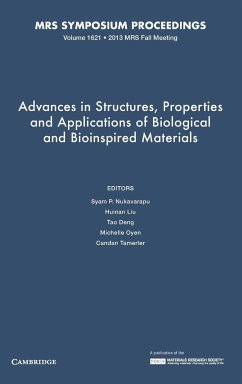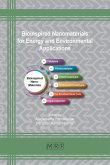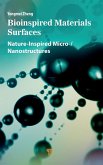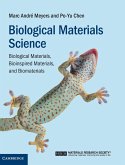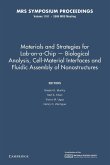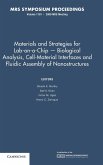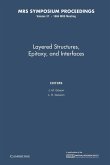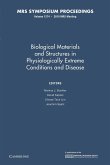Advances in Structures, Properties and Applications of Biological and Bioinspired Materials
Herausgeber: Nukavarapu, Syam P.; Deng, Tao; Liu, Huinan
Advances in Structures, Properties and Applications of Biological and Bioinspired Materials
Herausgeber: Nukavarapu, Syam P.; Deng, Tao; Liu, Huinan
- Gebundenes Buch
- Merkliste
- Auf die Merkliste
- Bewerten Bewerten
- Teilen
- Produkt teilen
- Produkterinnerung
- Produkterinnerung
This volume contains papers from symposia H, C, D and J at the MRS 2013 fall meeting.
Andere Kunden interessierten sich auch für
![Bioinspired Nanomaterials for Energy and Environmental Applications Bioinspired Nanomaterials for Energy and Environmental Applications]() Bioinspired Nanomaterials for Energy and Environmental Applications109,99 €
Bioinspired Nanomaterials for Energy and Environmental Applications109,99 €![Bioinspired Materials Surfaces Bioinspired Materials Surfaces]() Yongmei ZhengBioinspired Materials Surfaces279,99 €
Yongmei ZhengBioinspired Materials Surfaces279,99 €![Biological Materials Science Biological Materials Science]() Marc André MeyersBiological Materials Science115,99 €
Marc André MeyersBiological Materials Science115,99 €![Materials and Strategies for Lab-On-A-Chip Biological Analysis, Cell-Material Interfaces and Fluidic Assembly of Nanostructures Materials and Strategies for Lab-On-A-Chip Biological Analysis, Cell-Material Interfaces and Fluidic Assembly of Nanostructures]() Materials and Strategies for Lab-On-A-Chip Biological Analysis, Cell-Material Interfaces and Fluidic Assembly of Nanostructures38,99 €
Materials and Strategies for Lab-On-A-Chip Biological Analysis, Cell-Material Interfaces and Fluidic Assembly of Nanostructures38,99 €![Materials and Strategies for Lab-on-a-Chip - Biological Anaylsis, Cell-Material Interfaces and Fluidic Assembly of Nanostructures Materials and Strategies for Lab-on-a-Chip - Biological Anaylsis, Cell-Material Interfaces and Fluidic Assembly of Nanostructures]() Materials and Strategies for Lab-on-a-Chip - Biological Anaylsis, Cell-Material Interfaces and Fluidic Assembly of Nanostructures139,99 €
Materials and Strategies for Lab-on-a-Chip - Biological Anaylsis, Cell-Material Interfaces and Fluidic Assembly of Nanostructures139,99 €![Layered Structures, Epitaxy, and Interfaces Layered Structures, Epitaxy, and Interfaces]() Layered Structures, Epitaxy, and Interfaces41,99 €
Layered Structures, Epitaxy, and Interfaces41,99 €![Biological Materials and Structures in Physiologically Extreme Conditions and Disease Biological Materials and Structures in Physiologically Extreme Conditions and Disease]() Biological Materials and Structures in Physiologically Extreme Conditions and Disease38,99 €
Biological Materials and Structures in Physiologically Extreme Conditions and Disease38,99 €-
-
-
This volume contains papers from symposia H, C, D and J at the MRS 2013 fall meeting.
Hinweis: Dieser Artikel kann nur an eine deutsche Lieferadresse ausgeliefert werden.
Hinweis: Dieser Artikel kann nur an eine deutsche Lieferadresse ausgeliefert werden.
Produktdetails
- Produktdetails
- Verlag: Cambridge University Press
- Seitenzahl: 286
- Erscheinungstermin: 19. Februar 2015
- Englisch
- Abmessung: 235mm x 157mm x 20mm
- Gewicht: 568g
- ISBN-13: 9781605115986
- ISBN-10: 1605115983
- Artikelnr.: 41314953
- Herstellerkennzeichnung
- Libri GmbH
- Europaallee 1
- 36244 Bad Hersfeld
- gpsr@libri.de
- Verlag: Cambridge University Press
- Seitenzahl: 286
- Erscheinungstermin: 19. Februar 2015
- Englisch
- Abmessung: 235mm x 157mm x 20mm
- Gewicht: 568g
- ISBN-13: 9781605115986
- ISBN-10: 1605115983
- Artikelnr.: 41314953
- Herstellerkennzeichnung
- Libri GmbH
- Europaallee 1
- 36244 Bad Hersfeld
- gpsr@libri.de
Part I. Advanced Composites and Structures for Tissue Engineering: 1.
Composites and structures for regenerative engineering; 2. Novel and unique
matrix design for osteochondral tissue engineering; 3. Reducing infections
using nanotechnology; 4. Identifying iron oxide based materials that can
either pass or not pass through the in vitro blood-brain barrier; 5.
Nanostructured ceramic and ceramic-polymer composites as dual functional
interface for bioresorbable metallic implants; 6. Novel silicone-epoxy
composites for dental restorations; 7. Development of
hydroxyapatite-mediated synthesis of collagen-based copolymers for
application as bio scaffolds in bone regeneration; 8. Size also matters in
biodegradable composite microfiber reinforced by chitosan nanofibers; 9.
Proliferation and osteogenic differentiation of mesenchymal stem cells on
biodegradable calcium-deficient hydroxyapatite tubular bacterial cellulose
composites; 10. Dielectrophoretical fabrication of hybrid carbon
nanotubes-hydrogel biomaterial for muscle tissue engineering applications;
11. In vitro examination of poly(glycerol sebacate) degradation kinetics:
effects of porosity and cure temperature; 12. Novel absorbable polyurethane
biomaterials and scaffolds for tissue engineering; 13. Control of cell
adhesion and detachment on temperature-responsive block copolymer Langmuir
films; 14. Biofunctional thermo-responsive polymeric surface with
micropatterns for label free cell separation; 15. Preliminary investigation
of a sacrificial process for fabrication of polymer membranes with
sub-micron thickness; 16. Fabrication and morphological investigation of
multi-walled electrospun polymeric nanofibers; 17. A novel injectable
chitosan sponge containing brain derived neurotrophic factor (BDNF) to
enhance human oligodendrocyte progenitor cells' (OPC) differentiation; Part
II. Advances in Mechanics of Biological and Bioinspired Materials: 18. DNA
i-motif provides steel-like tough ends to chromosomes; 19. Scanning
acoustic microscopy of biological cryosections: the effect of local
thickness on apparent acoustic wave speed; 20. The structure and the
mechanical properties of a newly fabricated
cellulose-nanofiber/polyvinyl-alcohol composite; 21. Modular peptide-based
hybrid nanoprobes for bio-imaging and bio-sensing; 22. Microstructure,
spectroscopic studies and nanomechanical properties of human cortical bone
with osteogenesis imperfect; Part III. Engineering and Application of
Bioinspired Structured Materials: 23. Mechanosensitive channels activity in
a droplet interface bilayer system; 24. Cellulose nanofibril (CNF)
reinforced starch insulating foams; 25. Degradation control of cellulose
scaffold by malaprade oxidation; 26. Toward bioinspired nanostructures for
selective vapor sensing: diverse vapor-induced spectral responses within
iridescent scales of morpho butterflies; 27. Integrative chemistry toward
biosourced SiC macrocellular foams bearing unprecedented heat transport
properties; 28. Preparation of porous B-type carbonate apatite with
different carbonate contents for an artificial bone substitute; 29. Science
of swimming and the swimming of the soft shelled turtle; 30. Effect of
microtubules hierarchy on photoinduced hydrogen generation and application
to artificial photosynthesis; Part IV. Materials for Neural Interfaces: 31.
Investigating the surface changes of silicon in vitro within physiological
environments for neurological application; 32. Quantification of axonal
outgrowth on a surface with asymmetric topography; 33. Improved biphasic
pulsing power efficiency with Pt-Ir coated microelectrodes; 34. Atomic
layer deposited Al2O3 and parylene C bi-layer encapsulation for Utah
electrode array based neural interfaces.
Composites and structures for regenerative engineering; 2. Novel and unique
matrix design for osteochondral tissue engineering; 3. Reducing infections
using nanotechnology; 4. Identifying iron oxide based materials that can
either pass or not pass through the in vitro blood-brain barrier; 5.
Nanostructured ceramic and ceramic-polymer composites as dual functional
interface for bioresorbable metallic implants; 6. Novel silicone-epoxy
composites for dental restorations; 7. Development of
hydroxyapatite-mediated synthesis of collagen-based copolymers for
application as bio scaffolds in bone regeneration; 8. Size also matters in
biodegradable composite microfiber reinforced by chitosan nanofibers; 9.
Proliferation and osteogenic differentiation of mesenchymal stem cells on
biodegradable calcium-deficient hydroxyapatite tubular bacterial cellulose
composites; 10. Dielectrophoretical fabrication of hybrid carbon
nanotubes-hydrogel biomaterial for muscle tissue engineering applications;
11. In vitro examination of poly(glycerol sebacate) degradation kinetics:
effects of porosity and cure temperature; 12. Novel absorbable polyurethane
biomaterials and scaffolds for tissue engineering; 13. Control of cell
adhesion and detachment on temperature-responsive block copolymer Langmuir
films; 14. Biofunctional thermo-responsive polymeric surface with
micropatterns for label free cell separation; 15. Preliminary investigation
of a sacrificial process for fabrication of polymer membranes with
sub-micron thickness; 16. Fabrication and morphological investigation of
multi-walled electrospun polymeric nanofibers; 17. A novel injectable
chitosan sponge containing brain derived neurotrophic factor (BDNF) to
enhance human oligodendrocyte progenitor cells' (OPC) differentiation; Part
II. Advances in Mechanics of Biological and Bioinspired Materials: 18. DNA
i-motif provides steel-like tough ends to chromosomes; 19. Scanning
acoustic microscopy of biological cryosections: the effect of local
thickness on apparent acoustic wave speed; 20. The structure and the
mechanical properties of a newly fabricated
cellulose-nanofiber/polyvinyl-alcohol composite; 21. Modular peptide-based
hybrid nanoprobes for bio-imaging and bio-sensing; 22. Microstructure,
spectroscopic studies and nanomechanical properties of human cortical bone
with osteogenesis imperfect; Part III. Engineering and Application of
Bioinspired Structured Materials: 23. Mechanosensitive channels activity in
a droplet interface bilayer system; 24. Cellulose nanofibril (CNF)
reinforced starch insulating foams; 25. Degradation control of cellulose
scaffold by malaprade oxidation; 26. Toward bioinspired nanostructures for
selective vapor sensing: diverse vapor-induced spectral responses within
iridescent scales of morpho butterflies; 27. Integrative chemistry toward
biosourced SiC macrocellular foams bearing unprecedented heat transport
properties; 28. Preparation of porous B-type carbonate apatite with
different carbonate contents for an artificial bone substitute; 29. Science
of swimming and the swimming of the soft shelled turtle; 30. Effect of
microtubules hierarchy on photoinduced hydrogen generation and application
to artificial photosynthesis; Part IV. Materials for Neural Interfaces: 31.
Investigating the surface changes of silicon in vitro within physiological
environments for neurological application; 32. Quantification of axonal
outgrowth on a surface with asymmetric topography; 33. Improved biphasic
pulsing power efficiency with Pt-Ir coated microelectrodes; 34. Atomic
layer deposited Al2O3 and parylene C bi-layer encapsulation for Utah
electrode array based neural interfaces.
Part I. Advanced Composites and Structures for Tissue Engineering: 1.
Composites and structures for regenerative engineering; 2. Novel and unique
matrix design for osteochondral tissue engineering; 3. Reducing infections
using nanotechnology; 4. Identifying iron oxide based materials that can
either pass or not pass through the in vitro blood-brain barrier; 5.
Nanostructured ceramic and ceramic-polymer composites as dual functional
interface for bioresorbable metallic implants; 6. Novel silicone-epoxy
composites for dental restorations; 7. Development of
hydroxyapatite-mediated synthesis of collagen-based copolymers for
application as bio scaffolds in bone regeneration; 8. Size also matters in
biodegradable composite microfiber reinforced by chitosan nanofibers; 9.
Proliferation and osteogenic differentiation of mesenchymal stem cells on
biodegradable calcium-deficient hydroxyapatite tubular bacterial cellulose
composites; 10. Dielectrophoretical fabrication of hybrid carbon
nanotubes-hydrogel biomaterial for muscle tissue engineering applications;
11. In vitro examination of poly(glycerol sebacate) degradation kinetics:
effects of porosity and cure temperature; 12. Novel absorbable polyurethane
biomaterials and scaffolds for tissue engineering; 13. Control of cell
adhesion and detachment on temperature-responsive block copolymer Langmuir
films; 14. Biofunctional thermo-responsive polymeric surface with
micropatterns for label free cell separation; 15. Preliminary investigation
of a sacrificial process for fabrication of polymer membranes with
sub-micron thickness; 16. Fabrication and morphological investigation of
multi-walled electrospun polymeric nanofibers; 17. A novel injectable
chitosan sponge containing brain derived neurotrophic factor (BDNF) to
enhance human oligodendrocyte progenitor cells' (OPC) differentiation; Part
II. Advances in Mechanics of Biological and Bioinspired Materials: 18. DNA
i-motif provides steel-like tough ends to chromosomes; 19. Scanning
acoustic microscopy of biological cryosections: the effect of local
thickness on apparent acoustic wave speed; 20. The structure and the
mechanical properties of a newly fabricated
cellulose-nanofiber/polyvinyl-alcohol composite; 21. Modular peptide-based
hybrid nanoprobes for bio-imaging and bio-sensing; 22. Microstructure,
spectroscopic studies and nanomechanical properties of human cortical bone
with osteogenesis imperfect; Part III. Engineering and Application of
Bioinspired Structured Materials: 23. Mechanosensitive channels activity in
a droplet interface bilayer system; 24. Cellulose nanofibril (CNF)
reinforced starch insulating foams; 25. Degradation control of cellulose
scaffold by malaprade oxidation; 26. Toward bioinspired nanostructures for
selective vapor sensing: diverse vapor-induced spectral responses within
iridescent scales of morpho butterflies; 27. Integrative chemistry toward
biosourced SiC macrocellular foams bearing unprecedented heat transport
properties; 28. Preparation of porous B-type carbonate apatite with
different carbonate contents for an artificial bone substitute; 29. Science
of swimming and the swimming of the soft shelled turtle; 30. Effect of
microtubules hierarchy on photoinduced hydrogen generation and application
to artificial photosynthesis; Part IV. Materials for Neural Interfaces: 31.
Investigating the surface changes of silicon in vitro within physiological
environments for neurological application; 32. Quantification of axonal
outgrowth on a surface with asymmetric topography; 33. Improved biphasic
pulsing power efficiency with Pt-Ir coated microelectrodes; 34. Atomic
layer deposited Al2O3 and parylene C bi-layer encapsulation for Utah
electrode array based neural interfaces.
Composites and structures for regenerative engineering; 2. Novel and unique
matrix design for osteochondral tissue engineering; 3. Reducing infections
using nanotechnology; 4. Identifying iron oxide based materials that can
either pass or not pass through the in vitro blood-brain barrier; 5.
Nanostructured ceramic and ceramic-polymer composites as dual functional
interface for bioresorbable metallic implants; 6. Novel silicone-epoxy
composites for dental restorations; 7. Development of
hydroxyapatite-mediated synthesis of collagen-based copolymers for
application as bio scaffolds in bone regeneration; 8. Size also matters in
biodegradable composite microfiber reinforced by chitosan nanofibers; 9.
Proliferation and osteogenic differentiation of mesenchymal stem cells on
biodegradable calcium-deficient hydroxyapatite tubular bacterial cellulose
composites; 10. Dielectrophoretical fabrication of hybrid carbon
nanotubes-hydrogel biomaterial for muscle tissue engineering applications;
11. In vitro examination of poly(glycerol sebacate) degradation kinetics:
effects of porosity and cure temperature; 12. Novel absorbable polyurethane
biomaterials and scaffolds for tissue engineering; 13. Control of cell
adhesion and detachment on temperature-responsive block copolymer Langmuir
films; 14. Biofunctional thermo-responsive polymeric surface with
micropatterns for label free cell separation; 15. Preliminary investigation
of a sacrificial process for fabrication of polymer membranes with
sub-micron thickness; 16. Fabrication and morphological investigation of
multi-walled electrospun polymeric nanofibers; 17. A novel injectable
chitosan sponge containing brain derived neurotrophic factor (BDNF) to
enhance human oligodendrocyte progenitor cells' (OPC) differentiation; Part
II. Advances in Mechanics of Biological and Bioinspired Materials: 18. DNA
i-motif provides steel-like tough ends to chromosomes; 19. Scanning
acoustic microscopy of biological cryosections: the effect of local
thickness on apparent acoustic wave speed; 20. The structure and the
mechanical properties of a newly fabricated
cellulose-nanofiber/polyvinyl-alcohol composite; 21. Modular peptide-based
hybrid nanoprobes for bio-imaging and bio-sensing; 22. Microstructure,
spectroscopic studies and nanomechanical properties of human cortical bone
with osteogenesis imperfect; Part III. Engineering and Application of
Bioinspired Structured Materials: 23. Mechanosensitive channels activity in
a droplet interface bilayer system; 24. Cellulose nanofibril (CNF)
reinforced starch insulating foams; 25. Degradation control of cellulose
scaffold by malaprade oxidation; 26. Toward bioinspired nanostructures for
selective vapor sensing: diverse vapor-induced spectral responses within
iridescent scales of morpho butterflies; 27. Integrative chemistry toward
biosourced SiC macrocellular foams bearing unprecedented heat transport
properties; 28. Preparation of porous B-type carbonate apatite with
different carbonate contents for an artificial bone substitute; 29. Science
of swimming and the swimming of the soft shelled turtle; 30. Effect of
microtubules hierarchy on photoinduced hydrogen generation and application
to artificial photosynthesis; Part IV. Materials for Neural Interfaces: 31.
Investigating the surface changes of silicon in vitro within physiological
environments for neurological application; 32. Quantification of axonal
outgrowth on a surface with asymmetric topography; 33. Improved biphasic
pulsing power efficiency with Pt-Ir coated microelectrodes; 34. Atomic
layer deposited Al2O3 and parylene C bi-layer encapsulation for Utah
electrode array based neural interfaces.

